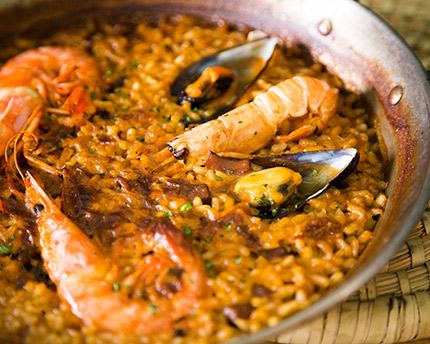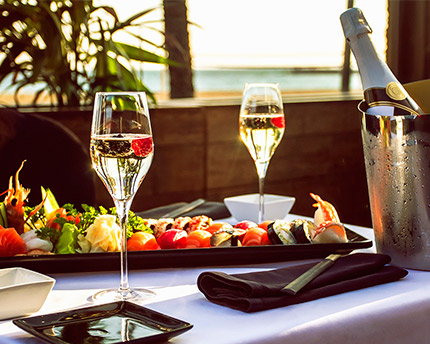Alicante’s traditional food revolves around the Mediterranean Sea, from which its finest delicacies originate. However, the main feature of the area’s cuisine, much like on the rest of the eastern coast of Spain, is rice. Bear in mind that this is a vegetable growing region, which is why legumes and vegetables are also responsible for some of the key dishes that make up Alicante’s traditional food.
Below are some of its most traditional and most famous dishes. However, it’s almost impossible to sample all the region’s local recipes, at least if you’re visiting for just a few days.
Arroz a banda
Rice is the archetypal ingredient of many of the restaurants in Alicante and arroz a banda is, without a doubt, one of the most popular. Alicante has its own version of the dish, which differs somewhat to the arroz a banda made in Valencia.
Back in the day, the rice was placed on the table with the fish and seafood to one side of it (literally ‘a banda’). However, these days it is all served together. The key to the dish’s delicious flavour is the fish broth in which the rice is cooked and a generous sofrito made of garlic, ñora peppers, tomatoes, cuttlefish and prawns, among other ingredients.
Arroz con costra
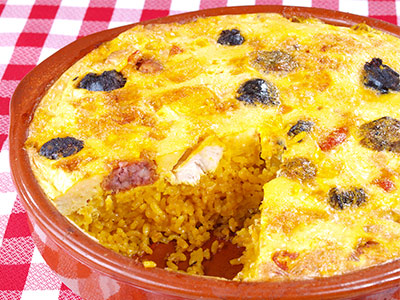
Out of all the traditional rice dishes of eastern Spain this is the most different, above all because of the ingredients that go into it (cold cuts of meat and beaten egg, as well as chicken and/or rabbit) and because of the fact it is cooked in a clay pot. To get its characteristic crispy texture (costra is Spanish for ‘crust’), it is finished off in the oven.
Paella alicantina
Like all paellas this one has many versions based on the main ingredients: fish, meat, chicken, rabbit, vegetables, etc. All the versions have one feature in common, however: salmorreta, the sauce in which the rice is sautéed. Salmorreta alicantina is made from tomatoes, garlic, parsley and ñora peppers, which are, to a large degree, responsible for the flavour and colour of this type of paella.
Mistela
Not quite a type of traditional food, mistela is in fact a drink, or to be more specific a liqueur made by adding alcohol to grape must, thus avoiding spontaneous fermentation. Before bottling, to give it a complex flavour and aromatics, herbs and sliced fruit may be added to the barrel in which the mistela is stored. It has a minimum alcohol proof of 13% and a maximum of 23% and is drunk as an aperitif, with dessert or as a digestif.
Turrón de Jijona
Turrón, a type of nougat, is without a doubt Alicante’s most popular traditional Christmas food. Homes up and down the region and the country will always have at least one bar of turrón alicantino during the festive period. In the case of Jijona (a type of soft turrón), it gets its texture by grinding almonds, its main ingredient, together with honey.
So important is the product for the economy of Jijona, the town from which it originates, and its region that production of this type of turrón is subject to the regulations of the Regulatory Council of the Protected Geographical Indication of Jijona and Turrón de Alicante.
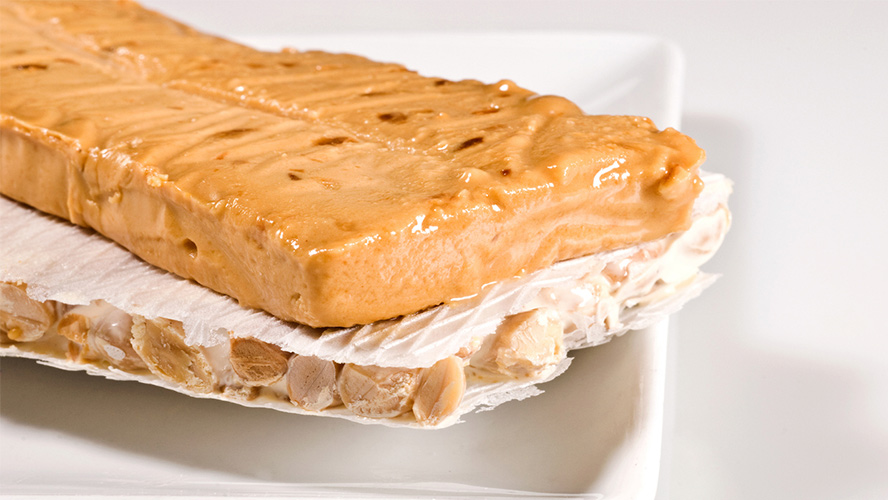
Although turrón de Alicante falls under the aforementioned PGI, it is quite different to that of Jijona, above all due to its texture. For this reason, it is known as turrón duro, or hard turrón. It also contains a large amount of almonds, but in this case they are not ground but diced. Like that of Jijona, turrón de Alicante also contains honey, however the ingredient responsible for emulsifying and making the other ingredients stick together is egg white.
Gachamiga
One of Alicante’s most popular traditional dishes, this simple creation made by shepherds is today associated with outdoor celebrations. The ingredients of gachamiga couldn’t be any simpler: flour, garlic, ñora peppers, extra virgin olive oil and longaniza (a sausage similar to chorizo), which are used to made a type of porridge that is browned over a campfire in a cooking pot on both sides like a tortilla.
Mojama de atún
Consisting of fillets of salt-cured tuna, mojama de atún is not the only delicacy to come from this oily fish that is a firm fixture in Alicante’s traditional food. Others salt-cured specialities include budellet (offal), sangatxo (the least red and lowest grade cut) and huevas (roe). In terms of mojama de atún, it is usually served in thin slices (like ham) dressed with a good glug of extra virgin olive oil.
Olleta alicantina
Olleta is, by definition, the archetypal stew of Alicante’s traditional food. It is made from legumes (lentils, chickpeas, white beans, borlotti beans and, on occasions, dried broad beans), which are cooked together with different vegetables, depending on the season, and different cuts of pork. It is served with a few grains of rice or wheat sprinkled over the dish as a garnish.
Borreta alicantina
Borreta is one of the best examples of Alicante’s traditional winter food. Similar in concept to potaje de vigilia, a cod and chickpea stew that is eaten at Lent and Easter, its core ingredient is some good salted cod, which is combined with potatoes, vegetables such as spinach, and the almost ubiquitous (at least in Alicante’s food) ñora peppers.
Toña alicantina
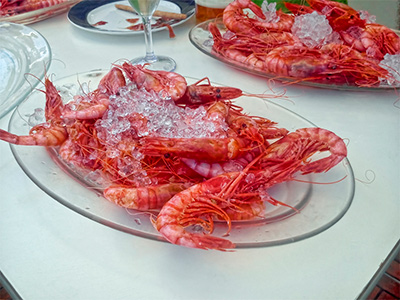
Toña is one of the sweet dishes that best defines Alicante’s traditional food. It is also known as panquemao and its shape and texture are similar to that of a bread roll, albeit with a crispier crust and a spongy interior like that of a sweet bun or sponge cake.
Fish and seafood
We can’t talk about Alicante’s traditional food without mentioning the magnificent fish and seafood found in the province’s wholesale and public markets (vincular a URL sobre Mercado Central de Alicante) where you can find species as succulent and characteristic as red Mediterranean prawns, crayfish and langoustines, squid and wedge clams. Many of them are the core ingredients of the eastern coast’s succulent rice dishes.




























































